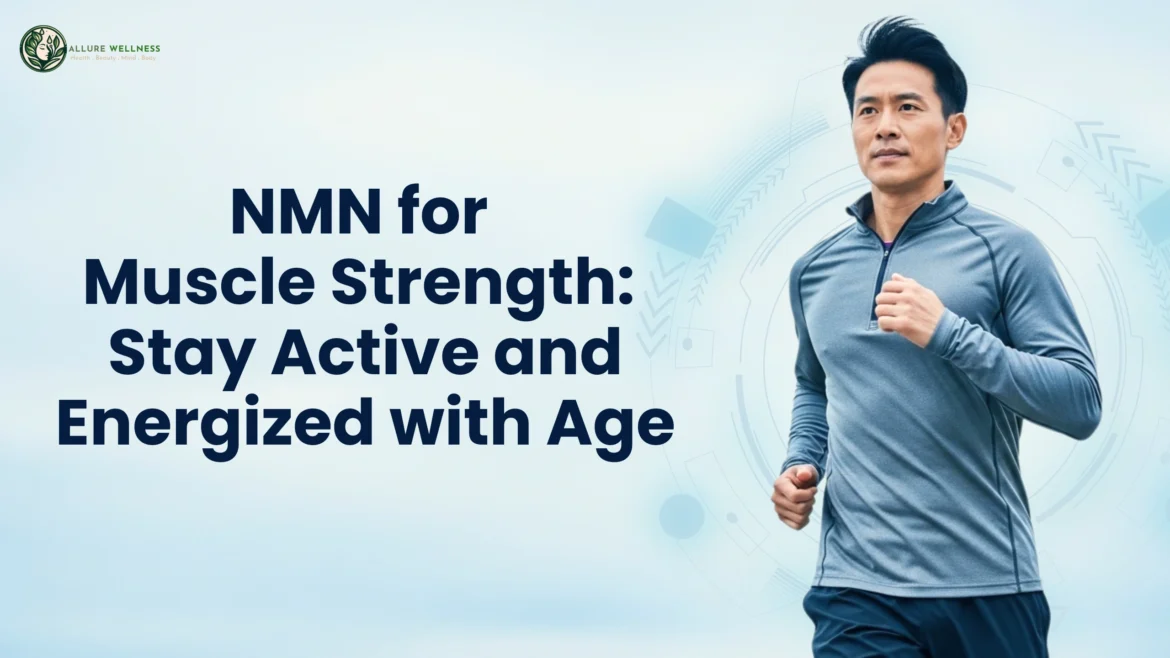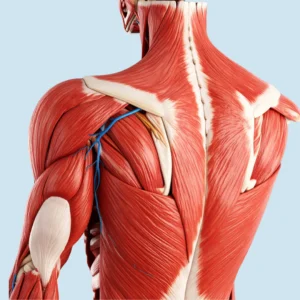As the years pass, our bodies naturally change. One of the most common changes is sarcopenia, the gradual loss of muscle mass and strength. This decline can begin as early as our thirties and accelerates with age. Less muscle means less energy and more risk of falls, injuries, and loss of independence.
Maintaining strong muscles is about more than looking fit. It supports mobility, balance, and even mental well-being. Strong muscles make everyday activities—climbing stairs, carrying groceries, or enjoying a long walk—easier and more enjoyable.
This is where NMN, short for nicotinamide mononucleotide, has gained attention. Researchers are exploring how this nutrient may help keep muscles strong and energized as we age. While it is not a magic pill, it offers exciting possibilities when combined with a healthy lifestyle.
Highlights
- NMN Boosts Cellular Energy for Muscles: NMN raises NAD+ levels, supporting ATP production and mitochondrial health to keep muscles strong and energized as you age.
- Aids Recovery & Blood Flow: It may enhance muscle repair and improve circulation, helping reduce fatigue and maintain performance.
- Works Best with Healthy Habits: NMN is most effective when paired with regular exercise, balanced nutrition, good sleep, and stress management.
Table of Contents
Understanding NMN and NAD+: The Energy Connection
So, what exactly is NMN? Nicotinamide Mononucleotide is a molecule found naturally in our cells. It is a direct precursor to NAD+, or nicotinamide adenine dinucleotide, a vital compound that powers many biological processes.
NAD+ is like a tiny battery for our cells. It helps convert the food we eat into usable energy. It also supports mitochondria, the “power plants” inside our cells, ensuring that our muscles have the energy they need to contract and recover.
Unfortunately, NAD+ levels decline with age, and this drop can contribute to fatigue and muscle weakness. NMN supplementation may help replenish NAD+ stores, supporting energy metabolism and overall muscle performance.
Four Ways NMN May Support Muscle Strength and Energy
 1. Improved Cellular Energy Production
1. Improved Cellular Energy Production
Muscles need a steady flow of ATP, the body’s main energy source, to contract and perform well. As we grow older, NAD+ levels naturally decline, making ATP production less efficient. NMN helps replenish NAD+, supporting the enzymes that create ATP and keeping energy levels steady. With more available energy, muscles can work harder and stay active for longer periods. This boost can help reduce fatigue, whether during workouts or simple daily activities.
2. Mitochondrial Health
Mitochondria are the cell’s “power plants,” producing the energy that keeps muscles strong and functional. When NAD+ levels drop, mitochondrial performance slows, leading to tired and less efficient muscles. NMN supports NAD+ restoration, helping mitochondria produce energy more effectively. Healthy mitochondria mean better endurance and less muscle fatigue during exercise or everyday movement. Over time, this may translate into improved strength and greater overall vitality.
3. Enhanced Recovery and Repair
Muscles grow stronger through a cycle of stress and repair after physical activity. Low NAD+ can slow this natural healing process, making recovery longer and more difficult. NMN helps boost NAD+ levels, giving cells the energy they need to rebuild and repair muscle fibers efficiently. Faster recovery allows for more consistent training and helps maintain muscle mass with age. It also reduces post-exercise soreness and keeps muscles resilient over time.
4. Better Blood Flow
Healthy circulation is essential for delivering oxygen and nutrients to active muscles. NAD+ plays a key role in keeping blood vessels flexible and functioning well. By replenishing NAD+, NMN may support stronger blood vessel health, which can improve blood flow to muscles. Better circulation ensures muscles receive the fuel they need to perform and recover effectively. This improved delivery system helps maintain energy and supports overall muscle performance as you age.
Key Research and Scientific Evidence
 Research on NMN is still in the early stages, but findings are promising.
Research on NMN is still in the early stages, but findings are promising.
- Muscle endurance and strength: Animal studies show NMN supplementation can improve endurance and muscle function in older mice.
- Age-related muscle decline: Early human studies suggest that NMN may help offset the natural decline in muscle strength associated with aging.
- Physical performance and energy metabolism: Some small clinical trials report that NMN supports energy metabolism, which could help older adults stay more active.
While these results are exciting, scientists emphasize that more human trials are needed. NMN is not a guaranteed solution, but it may become an important tool for healthy aging.
NMN and Lifestyle Synergy
For the best results, NMN should work alongside healthy habits. Here’s how it fits into a well-rounded approach:
| Lifestyle Habit | How It Works with NMN |
| Exercise & Resistance Training | Strength training helps build and preserve muscle; NMN may enhance the energy needed for workouts. |
| Balanced Nutrition | Adequate protein, vitamins, and minerals support muscle repair; NMN provides an extra boost for energy metabolism. |
| Sleep & Recovery | Quality rest allows muscles to heal and grow; NMN may aid in the repair process by supporting cellular health. |
Safe Use: Dosage, Forms, and Considerations
Studies often explore daily doses of 250–500 mg of NMN. It is available in capsules, powders, and sublingual (under-the-tongue) supplements.
Most people tolerate NMN well, but some may experience mild side effects such as digestive discomfort. Because supplements are not strictly regulated, it is important to choose a reputable brand and consult a healthcare provider before starting any new regimen.
Limitations and What to Keep in Mind
It’s important to stay realistic. Research is still emerging, and NMN is not a replacement for exercise or balanced nutrition.
Also, the quality and purity of NMN supplements can vary. Always look for products tested by third-party labs and speak with a healthcare professional to ensure it fits your individual needs.
Practical Tips for Staying Active with Age
To truly stay energized and strong, combine NMN (if your doctor agrees) with smart lifestyle habits:
- Exercise regularly with a mix of strength and aerobic activities.
- Eat protein-rich meals to support muscle repair.
- Stay hydrated and manage stress to protect energy levels.
- Be consistent and set realistic goals—progress takes time.
These habits, paired with NMN, can help you feel more active and confident at any age.
Final Thoughts: Supporting Lifelong Strength and Vitality
 Growing older doesn’t mean slowing down. With smart habits—like regular exercise, balanced nutrition, and good rest—you can stay strong and energized well into later years. NMN may give you an extra edge by supporting cellular energy and muscle health, but it works best as part of an overall healthy-aging routine. Think of it as a powerful partner, not a shortcut. Before starting any supplement, talk to your healthcare provider to ensure it fits your needs.
Growing older doesn’t mean slowing down. With smart habits—like regular exercise, balanced nutrition, and good rest—you can stay strong and energized well into later years. NMN may give you an extra edge by supporting cellular energy and muscle health, but it works best as part of an overall healthy-aging routine. Think of it as a powerful partner, not a shortcut. Before starting any supplement, talk to your healthcare provider to ensure it fits your needs.
Take the first step today: pair smart lifestyle choices with professional guidance to keep your body active, resilient, and ready for life’s adventures.
Frequently Asked Questions (FAQs)
Is NMN safe for older adults?
Early research suggests NMN is generally well tolerated, but it’s important to consult a healthcare professional before starting any supplement.
How soon can I feel the effects?
Some people notice improved energy or stamina within a few weeks, though results vary and long-term benefits are still being studied.
Can I take NMN without exercising?
You can, but exercise is essential for maintaining muscle strength. NMN works best when paired with regular physical activity.
Is NMN the same as NR (Nicotinamide Riboside)?
Both compounds help boost NAD+ levels, but they differ in structure and how the body processes them. Researchers are still comparing their effectiveness.
Where can I buy quality NMN supplements?
Look for brands that provide third-party testing and transparent labeling to ensure purity and potency. Always buy from trusted retailers or directly from reputable manufacturers

 1. Improved Cellular Energy Production
1. Improved Cellular Energy Production

